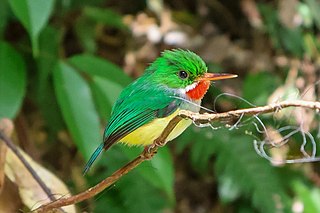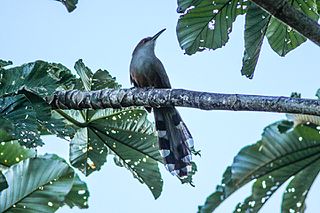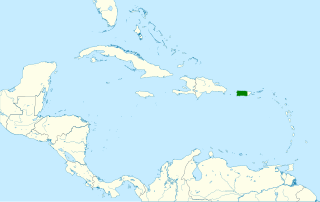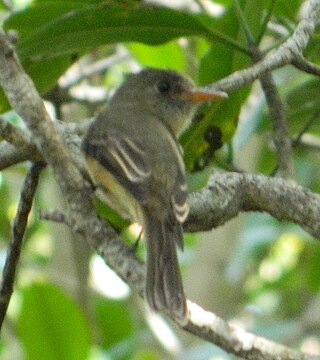
The Puerto Rican emerald, or zumbadorcito de Puerto Rico in Spanish, is species of hummingbird in the "emeralds", tribe Trochilini of subfamily Trochilinae. It is endemic to Puerto Rico.

The Puerto Rican tody is a bird endemic to Puerto Rico. It is locally known in Spanish as "San Pedrito" and "medio peso".

The Puerto Rican nightjar or Puerto Rican whip-poor-will is a bird in the nightjar family found in the coastal dry scrub forests in localized areas of southwestern Puerto Rico. It was described in 1916 from bones found in a cave in north central Puerto Rico and a single skin specimen from 1888, and was considered extinct until observed in the wild in 1961. The current population is estimated as 1,400-2,000 mature birds. The species is currently classified as Endangered due to pressures from habitat loss.

The Puerto Rican woodpecker is the only woodpecker endemic to the archipelago of Puerto Rico and is one of the five species of the genus Melanerpes that occur in the Antilles. Furthermore, it is the only resident species of the family Picidae in Puerto Rico. The species is common on the main island of Puerto Rico and rare on the island of Vieques.

Adelaide's warbler is a bird endemic to the archipelago of Puerto Rico belonging to the genus Setophaga of the family Parulidae. The species is named after Adelaide Swift, daughter of Robert Swift, the person who captured the first specimen.

The Puerto Rican owl or múcaro común, formerly known as the Puerto Rican screech owl, is a mid-sized "typical owl" in subfamily Striginae. It is endemic to the archipelago of Puerto Rico though it formerly also inhabited the Virgin Islands.

The Puerto Rican lizard cuckoo is a species of bird in the tribe Phaenicophaeini, subfamily Cuculinae of the cuckoo family Cuculidae. It is endemic to Puerto Rico.

The fauna of Puerto Rico is similar to other island archipelago faunas, with high endemism, and low, skewed taxonomic diversity. Bats are the only extant native terrestrial mammals in Puerto Rico. All other terrestrial mammals in the area were introduced by humans, and include species such as cats, goats, sheep, the small Indian mongoose, and escaped monkeys. Marine mammals include dolphins, manatees, and whales. Of the 349 bird species, about 120 breed in the archipelago, and 47.5% are accidental or rare.

The Puerto Rican vireo is a small bird endemic to the archipelago of Puerto Rico and one of the 31 species belonging to the genus Vireo of the family Vireonidae. Its local name is bien-te-veo, not to be confused with the unrelated great kiskadee - also known as bien-te-veo - which is found elsewhere.

Myiarchus is a genus of birds in the tyrant flycatcher family Tyrannidae. Most species are fairly similar in appearance and are easier to separate by voice than by plumage.

The pearly-eyed thrasher is a bird in the thrasher family Mimidae. It is found on many Caribbean islands, from the Bahamas in the north to the Grenadines in the south, with an isolated subspecies on Bonaire.

The Lesser Antillean pewee is a species of bird in the family Tyrannidae.

The Galápagos flycatcher also known as the large-billed flycatcher is a species of bird in the family Tyrannidae. It is endemic to the Galápagos Islands, where it is present on all the main islands. Its local name is 'Papamoscas'. The species was once placed in its own genus, Eribates, based upon a supposed "very long tarsus".

The Yucatan flycatcher is a species of bird in the family Tyrannidae.

The Puerto Rican parakeet or Puerto Rican conure is an extinct species of parrot that was found on Mona Island and possibly in Puerto Rico.

The Puerto Rican oriole is a species of bird in the family Icteridae, and genus Icterus or New World blackbirds. This species is a part of a subgroup of orioles that includes the North American orchard oriole, Icterus spurius, and the hooded oriole, Icterus cucullatus.

Guajataca State Forest is one of the 20 forests that make up the public forest system of Puerto Rico. The Guajataca Forest is located in the northwestern part of Puerto Rico, along the Northern Karst zone in the municipality of Isabela and municipality of Quebradillas, and is near Camuy and San Sebastián. The forest is renowned for its ecological diversity, the mogotes and karstic formations, and its numerous caves and canyons. It also has the largest trail system of any Puerto Rican state forest.




















